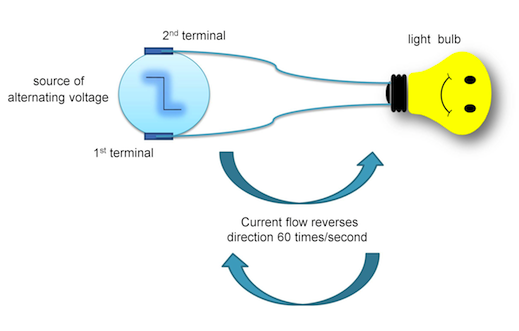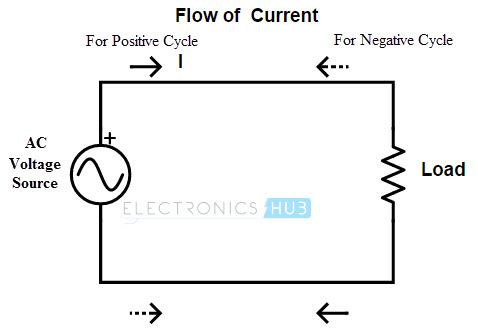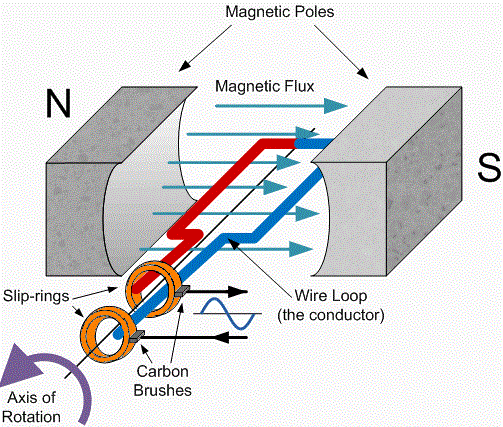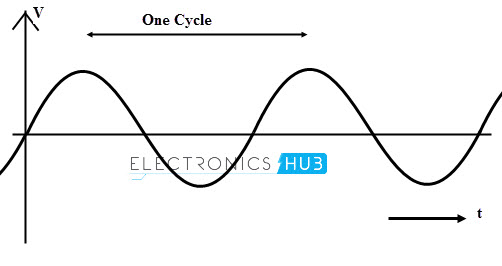Can you imagine your life without electricity? If there is no electricity there will be no progress in our lives. In this tutorial we will learn about what is an alternating current ? Let us first learn how and when electric current came into existence.
Electricity is not invented , it exists in nature in the form of energy . Many experiments were conducted on electricity. Benjamin Franklin dangerous kite experiment proved that lightning is electricity. Nikola Tesla and Thomas Edison invented A.C. current and D.C. current receptively. And these scientists battled over the standardisation of the current notation.Finally the alternating current won the battle and came into existence.

Outline
ToggleWhat is Alternating Current??
The current, which reverses its direction periodically in second , is called “Alternating Current”.The polarity of the voltage , is reversed periodically in an Alternating Current source. So the current reverses its direction periodically. Hence the name Alternating Current (AC) indicating current is alternating (periodically).
Number of times this current changes its direction in one second can be defined as the frequency of the alternating current. 50Hz frequency means it changes it direction for 50 times in a second.
In this current, the charged particles move from zero to maximum value in a direction and fall to zero and goes for another cycle in the opposite direction with the same values (in negative) . The values processed by AC current in both the directions are equal at all instances.
It has both magnitude, direction and it varies in accordance with time. AC will flow in both positive and negative directions and hence it is Bi-directional. Generally AC waveform is represented by Sinusoidal waveform and its mathematical formula is
A (t) = A sin (2πƒt)
Where ,
A is magnitude of signal
t is the time period
f is the frequency of signal
Generation of Alternating Current
Alternating current generating devices are called Alternators. The alternating current can be generated by many methods and by using many circuits. The simplest method of generating AC current is ‘Using Basic Single Coil AC Generator’.
Working principle
An AC generator works depending upon the principle of Faraday’s electromagnetic induction to convert mechanical energy (such as rotation) into electrical energy.
Construction
A simple generator consists of two permanent magnets. They will produce a fixed magnetic field between north & south poles. In this magnetic field, there will be a single rectangular loop of wire which is an important part of the alternator.
It will rotate around a fixed axis in the magnetic field generated by the pole magnets and it cuts the magnetic flux. The central axis is perpendicular to the magnetic field generated by the two poles.
Process of Alternating Current Generation
- In the beginning, the wire is parallel to the field and does not cut magnetic flux i.e. the lines of magnetic force. So there is no voltage induced in the loop.
- As the wire rotates in a counter-clockwise direction, the wire sides will cut the magnetic lines of force in opposite directions.
- The induced EMF in the loop at any instant of time is proportional to the angle of rotation of the wire loop.
- When the wire loop has rotated for 180o across the magnetic lines of force in the opposite direction, then electrons in the wire flow in the opposite direction.
- This means, for every complete revolution (360o) of wire, one full sinusoidal waveform is produced.
- The rotating wire in magnetic field always connected with the carbon brushes and slip rings in all times.
- These are used to transfer the electrical current induced in the coil.
- The amount of EMF induced in a coil is determined by its speed, strength, and length.
- We know that ‘frequency’ is Number of cycles per second.
- Number of cycles produced will depend upon the speed of the rotating wire. That means the more the speed of the coil, the more will be the frequency. That means f is directly proportional to n, where ‘n’ number of revolutions of wire.
- The periodic reversal of polarity results in the generation of a voltage that has alternating polarity and hence the alternating current.
AC Wave Form
The alternating current can be represented by a waveform, with its amplitude and time period. There are many wave forms with which we can represent the AC current like square wave or triangular wave, but the easiest is to represent it with a sine wave.
For every complete cycle of the sine wave, we see a positive half and a negative half cycle. These positive and negative half cycles will represent that the AC current will change its direction periodically. We will discuss all the properties of sine wave in further sessions.
Mains (line) supply
The general purpose electric power supplied to households is called Mains electricity. The current in this supply is alternating current. The supply which is connected from the transformer power lines (Step up or step down) to the domestic power lines is called “Main supply or Line supply”. The main supply we use for home purpose in India is 220-240 volts with 50Hz frequency whereas in the US (United States) it is 120 volts with 60Hz frequency. The manufacturers of electrical equipment will design their products according to the Mains supply so that it will work for the required range of voltage and frequency.
Advantages of AC over DC
- If we consider the cost of generating AC and DC currents, the cost of AC current generation is cheaper than that of DC current generation.
- Machines using Alternating current are simple in design and their maintenance is also easy compared to machines using DC current.
- We can use the AC current for long distance transmission, but not DC because the voltage range of alternating current is high.
- AC current can be easily transformed from low to high voltage or high to low voltage by using a transformer. Hence the range of voltages in AC current is very wide.
- Without any loss we can convert the AC current to DC by using rectifiers and we can limit the magnitude of AC current with the help of an inductor or conductor at a very considerable loss.
- Long distance transmission losses in AC current are very less compared to DC transmission, when the supplied voltage is high.
- AC motors will produce a higher output (higher torque) than DC motors.
Disadvantages
- The peak value of AC current is high, so it is very dangerous to use without insulation.
- AC transmission cost is very high compared to DC transmission.
- It a gives repelling shock of high voltage to a person who touches it and can cause electrocution.
- There is a chance of interference with communication signals.
- Applications of AC current
- All the electrical appliances we use in our day to day life work with AC current supply only. Ex: T.V., refrigerator, bulb, fan, Air conditioner etc.
- Alternating current is used in equipments where high power signals are transmitted. We use the Alternating Current in high power distribution systems like Antenna wave propagation, radio waves and ultrasonic wave propagation.
- We also use AC current in transformers for long distance transmission, to supply for many other purposes.
- Mainly we use the type of current in industries where the power requirement is high.





3 Responses
I like you lessons they are the best
Just loved it
nice lesson